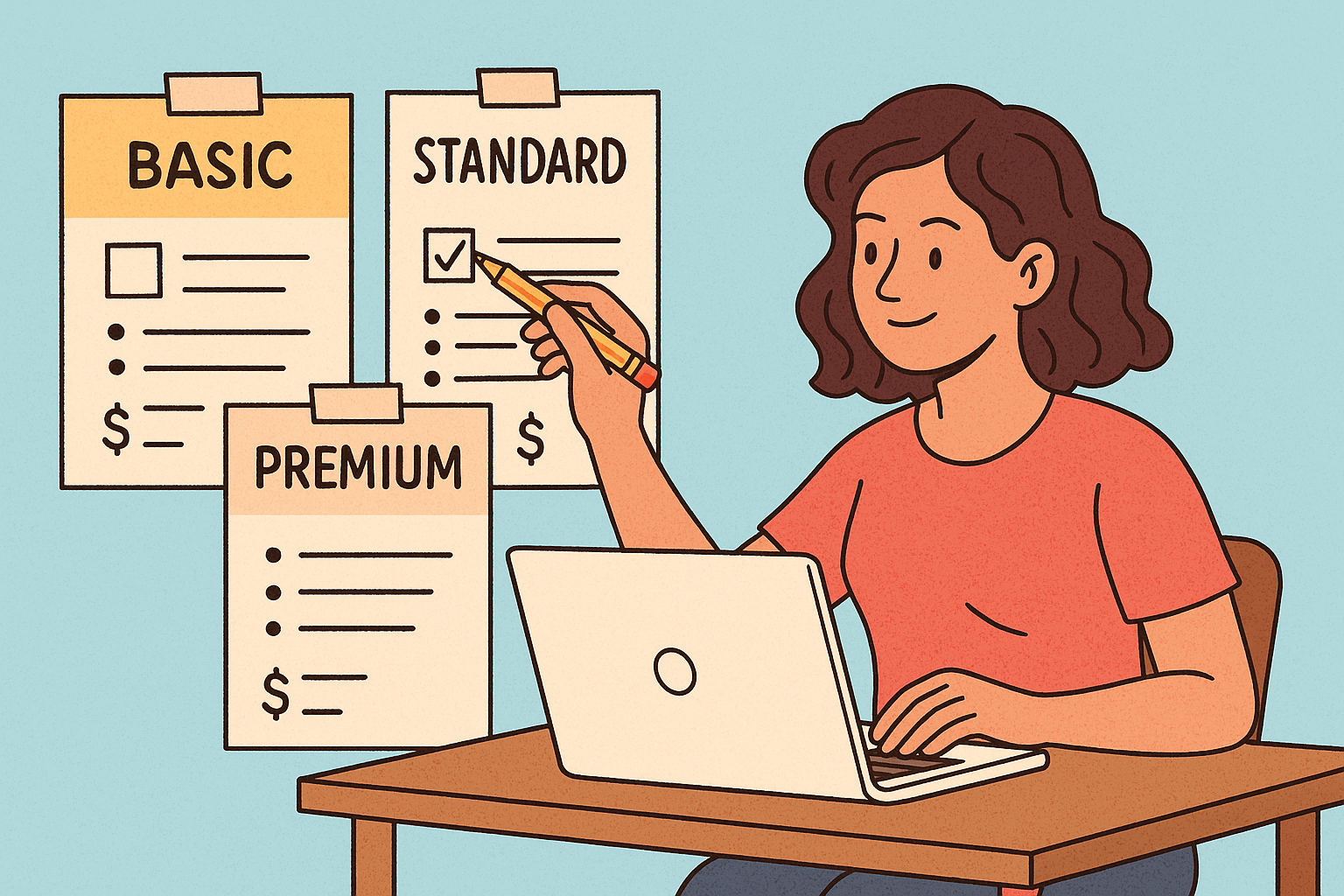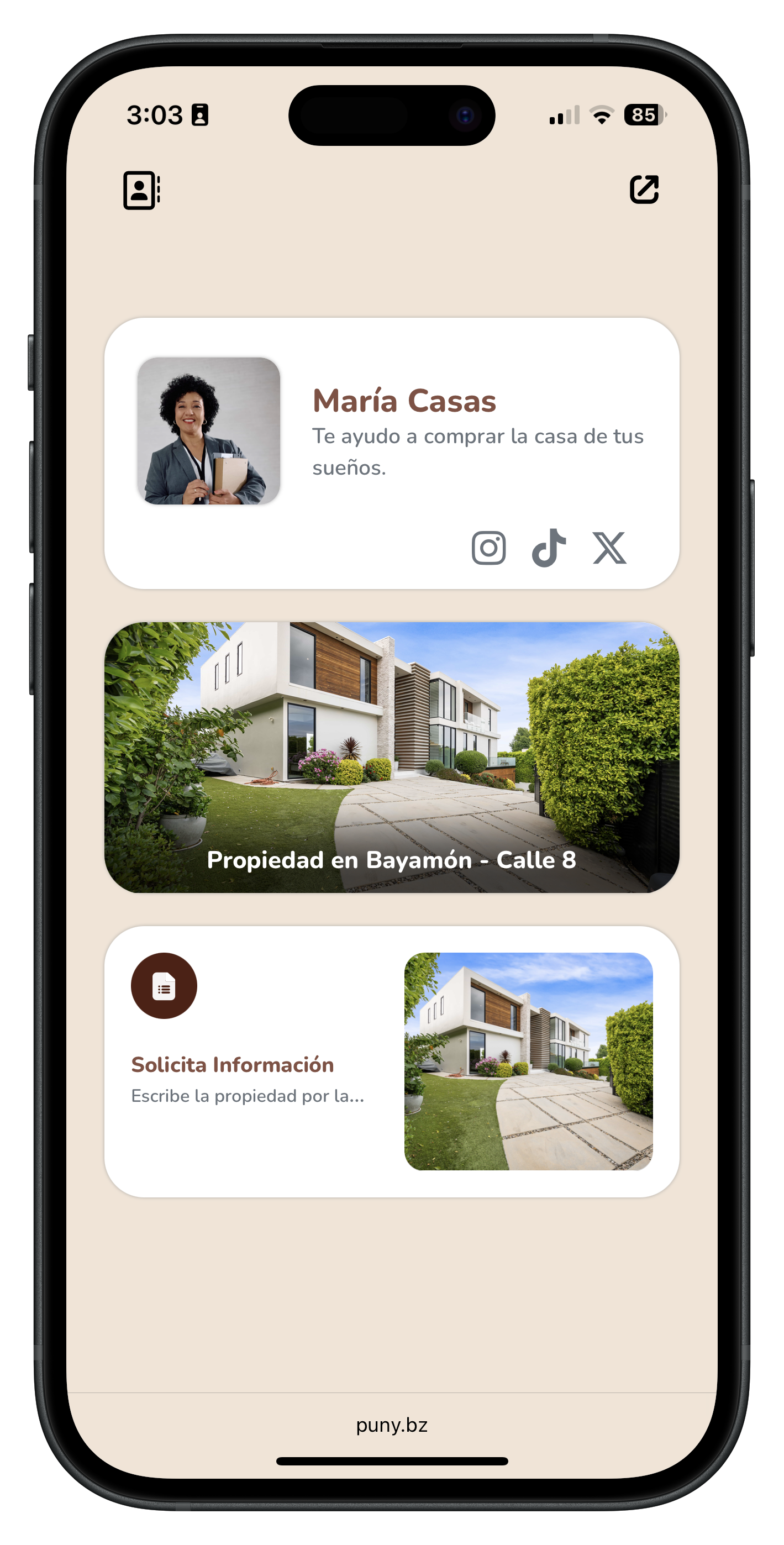This practical guide helps you package your services into clear, sellable offers. Follow the steps, copy the templates, and launch a package page ready to take payments in minutes.
Quick prep
Gather these before you start:
- List of current services and the outcomes they deliver.
- Real time it takes to fulfill each service, including prep, travel, communication, and post‑sale.
- Direct costs (materials, licenses, transport, platforms) and indirect costs (target salary, rent, tools).
- Weekly capacity: hours available for billable work.
- 3 frequent customer questions and 3 common objections.
1) Define the outcome and the customer for each package
Objective: help the customer see at a glance what they get and who it is for.
Guiding questions:
- What change does the customer achieve after the service? Make it measurable or obvious.
- Who is it for? Level, occasion, project size.
- What problem does it remove or prevent?
Value proposition one‑liner template:
For [profile/industry] who want [specific outcome], I offer [package name] that includes [3–5 key components], in [duration] for [price].
2) Choose your packaging model
Use a simple, scalable ladder:
- Basic: minimum viable solution to the main problem.
- Standard: most purchased; best balance between price and value.
- Premium: more depth, customization, and support.
Practical rules:
- Clear differentiation between levels. Add scope, not “loose hours”.
- Start with a maximum of 3 packages.
3) Define scope precisely
Avoid ambiguity. For each package specify:
- What is included: deliverables, number of iterations or revisions, support channels.
- What is not included: explicit limits to avoid scope creep.
- Duration: session or project time and delivery timelines.
- Client requirements: materials, forms, availability, approvals.
Scope checklist
- [ ] Enumerated deliverables
- [ ] Max number of revisions/iterations
- [ ] Clear times and deadlines
- [ ] Explicit exclusions
- [ ] Client requirements
4) Calculate real times and capacity
- Time per service (Ts): execution + prep + logistics + communication + post‑sale.
- Weekly capacity (Wc): billable hours available.
- Package limit per week (Pw): Pw = Wc / Ts (round down).
- Keep a 20% buffer for contingencies and marketing.
5) Design your pricing structure
Combine approaches so it is sustainable and competitive.
A) Cost‑plus (minimum floor)
Minimum price = Direct costs + Allocated indirect costs + Your target margin.
- Indirect costs per hour × service hours.
B) Time‑based (operational floor)
Time price = Target hourly rate × Ts.
C) Value‑based (rational ceiling)
Value price = % of perceived value, savings, or extra revenue created.
- Guide: 10–30% of the economic value created or saved when applicable.
Final package price = max(A, B) adjusted toward C based on market and differentiation.
Include surcharges: rush, off‑hours, extra scope.
6) Standard policies and terms
Make policies visible on every package card:
- Booking/deposit: 20–50% to lock the date.
- Cancellations and rescheduling: window (e.g., 48–72 h) and penalty.
- Guarantees/limitations: what is corrected and within what window.
- Ownership/use of deliverables: licenses, credits, source materials.
- Service areas and travel: included radius and extra charges.
Short policy template (adaptable):
“To reserve, a non‑refundable 50% deposit is required. Rescheduling with 48 h notice at no cost. Cancellations within 48 h forfeit the deposit. The package includes up to 2 revisions; additional ones are quoted separately. Prices valid for 30 days. Outside a 10 km radius: +$X per km.”
7) Structure your add‑ons and upsells
List extras that don’t warrant a new package:
- Extra deliverables, rush or priority, extra sessions, reports, extended support, travel, special equipment.
Define a fixed price per add‑on and when they apply.
8) Create your package cards
Card template (copy/paste):
Package name — For [profile/occasion]
Outcome: [main benefit in 1 sentence]
Includes:
- [Deliverable 1] • [Deliverable 2] • [Deliverable 3]
Duration/Timelines: [X time]
Not included: [3 key exclusions]
Price: $[amount] | Deposit: $[amount/%]
Key policies: [2–3 bullets]
How to book: [link/form/brief step]
9) Booking and fulfillment flow
- Express discovery: short form with goal, date, context.
- Package selection: side‑by‑side comparison page.
- Booking and deposit payment: confirm date and terms.
- Onboarding: automatic checklist or brief and calendar.
- Delivery: execution plus milestone confirmations.
- Close: final delivery, feedback, testimonial, next step proposal.
10) Messaging and quick replies
Standard reply to inquiries:
“Thanks for reaching out. Here you can see my packages with pricing, availability, and book in 1 minute: [link]. If you have a special situation, reply to this message and I’ll help.”
Short comparison copy for your page:
- Basic: for [profile] who need [outcome].
- Standard: most chosen; includes [differentiating value].
- Premium: for maximum personalization, speed, or support.
11) Indicators to iterate
Measure weekly:
- Click‑to‑booking rate (CR): bookings ÷ visits to the package page.
- Repeated questions: if >10% ask the same thing, clarify it on the card.
- Delivery time vs. plan: if you slip, reduce scope or raise price.
- Margin per package: revenue − actual costs.
- Use of add‑ons: spot extras that deserve their own package.
Improvement cycle: adjust one variable per week (price, scope, copy, or policies) and measure.
12) Multi‑industry examples (base list)
Makeup/Beauty
- Basic: Natural makeup, 60 min, includes basic lashes; 1 touch‑up.
- Standard: Event glam, 75–90 min, premium lashes + mini kit.
- Premium: Bride, trial + wedding day + touch‑up; extended‑hours policy.
Photography
- Basic: 45 min, 20 edited photos.
- Standard: 90 min, 50 photos, 2 locations.
- Premium: 3 h, 100 photos, album + priority delivery.
Coaching/Consulting
- Basic: single 60‑min session + 1‑page action plan.
- Standard: 4 sessions + email follow‑up.
- Premium: 8 sessions + initial audit + 30‑day chat support.
Cleaning
- Basic: maintenance 2 h, common areas.
- Standard: 4 h, includes deep kitchen/bath.
- Premium: move‑in/out, full checklist + oven/grates.
Design/Branding
- Basic: starter logo, 2 concepts, 2 revisions.
- Standard: essential identity (logo + palette + type + 3 assets).
- Premium: brand system + PDF guide + editable templates.
Tutoring/Classes
- Basic: diagnostic + 1 class.
- Standard: monthly package (4 classes) + study material.
- Premium: intensive 8 classes + mock tests + Q&A support.
Training/Wellness
- Basic: 1 session + base routine.
- Standard: monthly plan + weekly chat.
- Premium: quarterly plan + basic nutrition + close follow‑up.
13) Common mistakes and how to avoid them
- “Includes whatever comes up”: define limits and revisions.
- Hourly pricing with no outcome: package around outcomes. Customers compare value, not minutes.
- Three identical packages: each level must solve a distinct need.
- Hidden policies: show them on the card and at checkout.
- No add‑ons: you lose revenue and flexibility.
14) One‑page mini‑workshop (doable today)
Complete this for one package, then replicate:
- Client profile
- One‑sentence outcome
- Includes (3–5 bullets)
- Not included (3 bullets)
- Duration and timelines
- Ts (total time)
- Direct costs
- Target hourly rate
- Minimum price = max(cost‑plus, time)
- Proposed final price (considering value)
- Deposit and key policies
- Add‑ons and prices
- Booking link/flow
15) Final checklists
Launch checklist
- [ ] 3 packages ready with clear cards
- [ ] Policies visible and confirmed in the payment flow
- [ ] Add‑ons with defined prices
- [ ] Pre‑booking form and synced calendar
- [ ] Quick messages configured
- [ ] Published comparison page
Monthly maintenance checklist
- [ ] Review metrics and margins
- [ ] Adjust copy for repeated questions
- [ ] Test a new add‑on or limited bonus
- [ ] Update examples and testimonials
Quick resources (text templates)
- Package card: use section 8.
- Policies: section 6.
- DM reply: section 10.
- Level comparison: section 10.
Ready to sell your packages without friction?
Create your free account on Puny.bz to publish your packages, generate payment links, book appointments, and automate reminders in minutes. Get started




